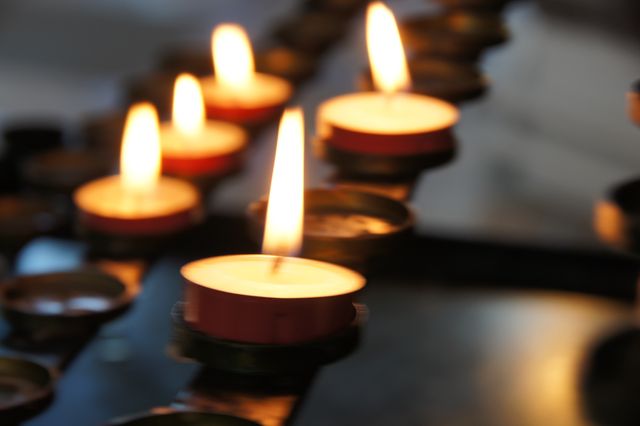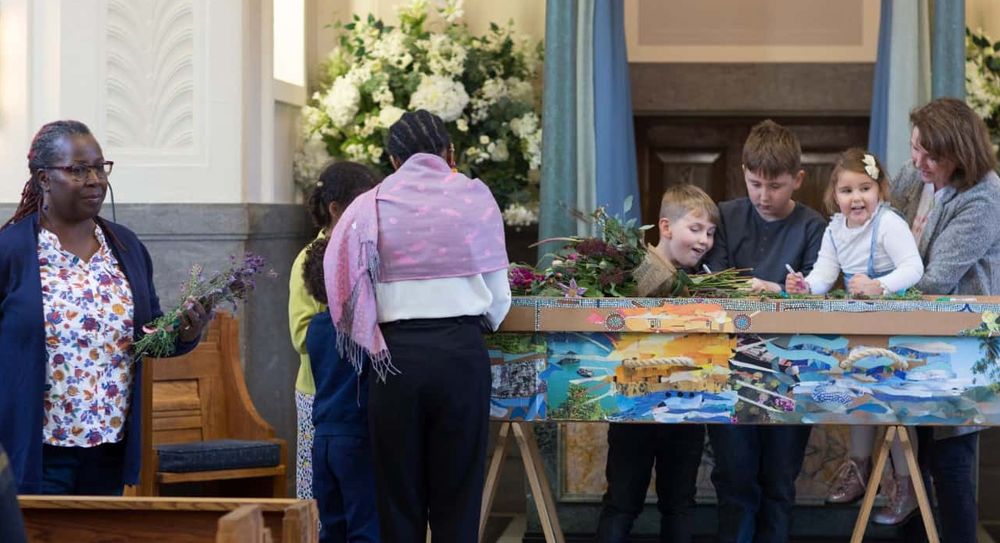Arranging a memorial service? Or want to learn more about them before you do? Here we’ll take you through the difference between a memorial service and a funeral service and how to plan one for a loved one.
What is a memorial service?
A memorial service is an opportunity for friends and family to come together to pay their respects to someone who’s passed away. It can be a formal ceremony or it can be a more casual get-together. It can take place shortly after their funeral or you can hold a service for them years later. It’s a chance to remember the person in the way you’d like. And it could help you cope with their loss or celebrate their life.
Is a memorial service the same as a funeral?
Not exactly. A funeral service and a memorial service are both types of ceremony where you can pay your respects to someone who’s died. The difference is that the body is there at a funeral service (usually in a coffin). But the body is not there at a memorial service. Instead some people might have the person’s ashes in an urn or a picture of the person who died.
What happens at a memorial service?
There are no rules about what happens at a memorial service. You can choose what to do. This depends on the final wishes of the person who died, what you’d like to include and what’s suitable for your budget.
To give you an idea of what to include here are some suggestions:
- Readings. These could be religious readings or prayers. Or they could be poems or passages from books. Choosing readings for a memorial service is a chance to share something that showcases the person’s personality. Or it can just be a chance to reflect and say goodbye. For more ideas our guide to selecting readings might help.
- Music. This is a chance to add a personal touch to the memorial service. You could play the person’s favourite song or even create a playlist of their favourite music to use for the ceremony.
- A eulogy or speech. A eulogy is typically seen as a funeral service speech. But there’s no reason why you can’t include one as part of a memorial service. Take it as an opportunity to talk about the life of the person who’s passed away. You could talk about how they affected you and the other people that were important to them.
- Photos. You could display photos of the person who died. Show them with their family and friends or at events and places that were important to them. This will help jog other people’s memories of the person and events they shared together. It’s an excellent way to pay your respects and celebrate the life of the person who’s passed away.
What to include on a memorial service program
You don’t have to make a memorial service program if you’re planning a smaller event. But if you’d like to put one together here are a few ideas of what to include:
- The name of the person who’s passed away
- Their date of birth and the date of their death
- Photo of the person
- Running order of the service (who’s speaking, at what times)
- Lyrics of music being played
- Readings or passages that’ll be read out
- Any favourite quotes to be included
- Thank you notes to family and friends who’ve helped
Learn how to make an order of service.
How long does a memorial service last?
A memorial service can last as long as you’d like. It could range from 20 to 60 minutes depending on what you include. But it really is down to what you think is suitable.
Where to hold a memorial service
You can hold a memorial service anywhere you like. It could be a small gathering at home or it could be held immediately after a cremation at the crematorium.
Here are some venue ideas to make arranging a memorial service easier:
Graveside
A graveside memorial service could happen immediately after the burial. Or you could have it a few days later in the cemetery. You could also hold a regular memorial service for the person each year on a date that’s special to you.
Graveside memorials can be religious. But they don’t have to be. Keep in mind that a churchyard or cemetery may have limits on how many people can attend. And try to be aware of other mourners who may be in the cemetery. Because graveside memorials are typically a time of mourning this tends to set the tone of the service. So this might help you decide if it’s the right fit for the memorial service you’re planning.
Crematorium
If the person who passed away is being cremated a memorial service at the crematorium could be suitable. Staff at the crematorium will be able to help you plan it. And you can also think about how you’d like to include the ashes. Would you like to place the urn at the front of the room with a flower display? Or perhaps next to a photo of the person? Whatever you include in the memorial service the crematorium can have a more traditional feel. So if that’s not what you’d like consider one of the other options below.
At home
A memorial service at home can be a personal get-together with close family and friends or it can be a larger event – it’s up to you. Have a think about what you want to include. Are flowers important? Do you need an order of service? Or would you just like to gather and share stories about your loved one? Being at home can be a more private way of saying goodbye. So if you want to keep things small this might be the best option for you. It could be the start of a tradition where the family can get together to remember the person who passed away – a good opportunity to get some old photos out and share memories.
Private venue
Having a memorial service at home may give you the personal touch you’re looking for. But if you need more space for a large number of family and friends a private venue might be the answer.
You could hire a venue like:
- Your local community centre
- Pub
- Hotel
- Village hall
A private venue could give you the space you need to share memories of your loved one with the people who are most important. It also means you can ask someone else to take care of the catering for you, if this is easier.
Do you bring flowers to a memorial service?
Guests aren’t expected to take anything to a memorial service unless the person organising it asks them to. You could send a card or flowers to the family of the person who died. Some families set up a donation page where you can donate to a charity instead of organising flowers.
What to wear to a memorial service
Do you have to wear black to a memorial service? Not necessarily. The person organising the service will usually set out the dress code on the invites. This could be an accessory in the favourite colour of the person who died. It could be brightly coloured outfits. Or it could be traditional black. If you’re unsure check with the person who is organising the service.
How to arrange a memorial service
Now that you have a clearer idea of what a memorial service can include here’s a list of how to arrange one to make planning easier:
- Figure out how many guests you’d like to invite. This will help you choose a venue that’s suitable.
- Book a venue if you need to and choose a date.
- Organise someone to lead the service whether it’s a religious leader or family member.
- Invite guests. Remember you don’t have to organise invitations. Perhaps an email or a phone call will do.
- Decide what you’d like to include in the memorial service and put together an order of service.
- Get in touch with florists and caterers if you need them.
- Organise any photos, videos or music you’d like to have at the service.
More memorial service ideas
Still not found the right thing to include? Here are some ideas which might help:
- A memorial balloon release can be an uplifting way to end the service. And a good way for guests to get involved too.
- Make a memorial book and encourage guests to add to it. Include photos, captions and stories for people to read.
- Plant a memory tree to leave behind a positive legacy for someone. Visit it when you can to remember your loved one too.
Photo by Eli Solitas on Unsplash.





